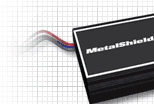 |
We put out electrons that interfere with ionic and electron currents that are generated by the metal on the car body. |
![]()


![]()
![]()
The Problem Corrosion on metal surfaces is caused by the combination of oxygen with iron and by the physical transport of ionized atoms from the metal surface when a conductive medium is present such as a water and salt solution. At a purely physical level, both types of corrosion can be considered a movement of electrical charge. These very small currents can cause severe damage to metal surfaces over time. The Solution Our method of corrosion control interferes with the microscopic currents on the metal surface described above and hence greatly reduces their effect. The trick is to get a current on the car body. Since the currents that we want to interfere with are very weak, we only need to generate a fairly small current to have a significant effect. We do this by periodically placing excess electrical charge on the car body. This excess charge changes the charge on the whole car body. Since this charge on the car body takes place in an finite amount of time we see that we are generating a small electrical current on the car body. This is the current that then interferes with the "corrosion currents". |
|
|||
| Cars for Sale | Want Ads | Parts & Service | Products | Events | Articles/Comments | Classic Car Links | | Photo & Art Gallery | Our Favorite Bumper Stickers | Ad Information | Ad Form | Home | e-mail | |